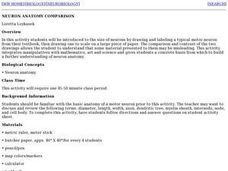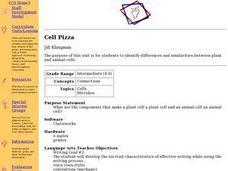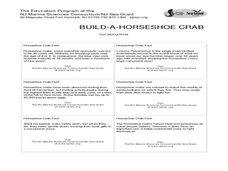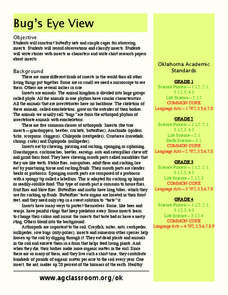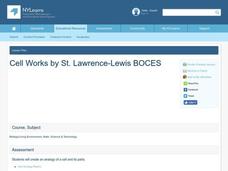Curated OER
Dinnertime On The Reef
Students identify the main parts of a coral reef. They describe a coral reef food chain.
Curated OER
Neuron Anatomy Comparison
Pupils create a scale model of a motor neuron that is two hundred times larger than the actual neuron. They identify the structures of a neuron and observe neurons under the microscope then use a worksheet to convert actual sizes into...
Curated OER
Cell Pizza
Students identify parts and functions of microscope. Students watch video, Cells and Life about cell parts with actual pictures and actual cells. Students discuss video and identify parts of the cells that animals and plants have in...
Curated OER
Build-A-Horseshoe Crab
Students discover many facts about horseshoe crabs. Students identify the main body parts of horseshoe crab. They explore the habits of the horseshoe crab and their importances to the ecosystem. Adaptations for younger students are...
Curated OER
An Introduction to 'Opae 'ula
Students examine the 'opae 'ula. In this science lesson, students observe a live specimen and identify the major body parts. Students construct habitat jars and observe the 'opae 'ula behaviors.
Curated OER
Soil Formation
Seventh graders investigate how soil is formed. They analyze types of soil samples, examine soil using a magnifying glass or microscope, complete a chart, conduct a soil and plant experiment, and construct a soil profile.
Curated OER
Bones
In this bones worksheet, pupils list and describe the functions of bones and give examples for each. Then they compare and contrast the microscopic structure of compact and spongy bone. Students also list the types of fractures and the...
Curated OER
How Does Your Garden Grow?
Students identify what plants need to grow. In this plant biology activity, students analyze the differences between an artificial plant and a live plant. Students plant seeds and discuss what plants need to grow. Students observe the...
Curated OER
Pond and Pond Organisms
Students explore pond ecosystems. In this pond organism activity, students will use pond water and a plastic bad in order to locate and identify freshwater organisms. The activity is designed for younger grades, but includes an...
Curated OER
Limu in Your Lunch
Pupils explore various types of algae found in Hawaii. In this science lesson, students research species of the three types of limu and identify various uses. Pupils explore products that contain limu.
Curated OER
Cell Factory
Students examine the basic structures and functions of cells. They design and construct a factory cell model where each factory part corresponds to a cell part.
Curated OER
Prokaryotic vs Eukaryotic
Learners identify via slides prokaryotic and eukaryotic cells. They identify plant or animal cells from slides or pictures. Students are given the question of the day. They are asked which has a nucleus, a prokaryotic or eukaryotic...
Curated OER
Atoms
Eighth graders explain what makes up matter. In this atoms lesson students define an atom and what its components are and identify properties of elements.
Curated OER
Bug's Eye View
Students explore biology by writing fictitious stories in class. In this insect life instructional activity, students identify many different types of insects in the animal kingdom and the classifications they fall into. Students collect...
Curated OER
Science: Suddenly Snow
Students engage in snow-related activities during the first winter snowfall. After explaining the elements needed for it to snow, they preserve snowflakes on frozen slides and observe them under a microscope. Then, they write diamante...
Curated OER
Brine Shrimp Anatomy
Third graders investigate the anatomy of the brine shrimp. They construct a model of the shrimp to demonstrate the anatomical parts of the shrimp. Students research the different factors that contribute to shrimp survival. Then they...
Curated OER
Home Sweet Home
Students examine the animals that live in trees. They identify their sounds, footprints and droppings. They draw pictures of the animals as well.
Curated OER
Make and Use a Plankton Net
Students make simple plankton nets and use them to collect and identify common forms of plankton. They identify and interpret plankton, as seen under a microscope, whether there was more zooplankton or phytoplankton. Finally, students...
Curated OER
Cell Works
Students identify the different parts of the cells and their functions. In this biology lesson, students create an analogy of a cell and its organelles. They make a poster and present it to class.
Curated OER
Fertilizer Frenzy
Learners design and conduct an experiment testing the effect of fertilizers/soaps on algal growth. They estimate and predict, identify the variables, formulate a hypothesis, and record and analyze the data, presenting their findings in a...
Curated OER
Biological Communities
Students identify consumers and producers in different communities. Students collect a variety of soil samples and record organisms found in the samples.
Curated OER
The Web of Life
Middle schoolers participate in a game in which they discover the balance of life in the ocean. They identify different organisms that rely on different types of food. They answer questions to complete the activity.
Curated OER
Mountain Pine Beetle
Students identify the different parts of a tree. In this biology lesson plan, students investigate how mountain pine beetles kill trees. They examine the beetles' anatomy using a microscope.
Curated OER
Powdery Mildew Fungi: Classification and Ecology
Students use a written key or illustrated key to identify fungi on plant leaves into its genus based on sexual or asexual reproduction, host range diversity, and host-parasite relationships.



